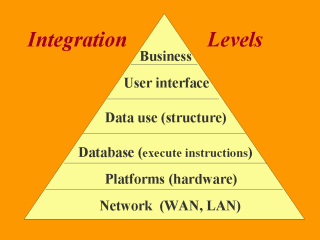| front |1 |2 |3 |4 |5 |6 |7 |8 |9 |10 |11 |12 |13 |14 |15 |16 |17 |18 |19 |20 |21 |22 |23 |24 |25 |26 |review |
 |
This diagram
illustrates various potential levels of integration. The foundation is the communications network to ensure full coverage of Public Health Services; this is followed by the hardware for data collections (server); the next step is the execution instructions that drive the operation of the database (reports generated); the next level up is the actual database structure that meets the needs of units (demographic tables); a further integration level is the user interface covering the electronic data transfer (HL7 format for transfer of pathology results); and finally the stage where business operations are facilitated by sharing the common capabilities of systems and units (such as early identification of events, issuing of reminders and sharing of staff skills). Keep in mind that integration of the various data bases needs not be the same across data sets, especially if this implies extra cost for no business benefit. For example, it may make sense to integrate the notifiable disease data set with the vaccinations register. And the breast cancer screening register with the mortality data base. But there may not be benefit in integrating or linking communicable diseases with breast cancer data. It is clear, then, that not all information systems will achieve integration at the business level given their different purposes and operating principles. |